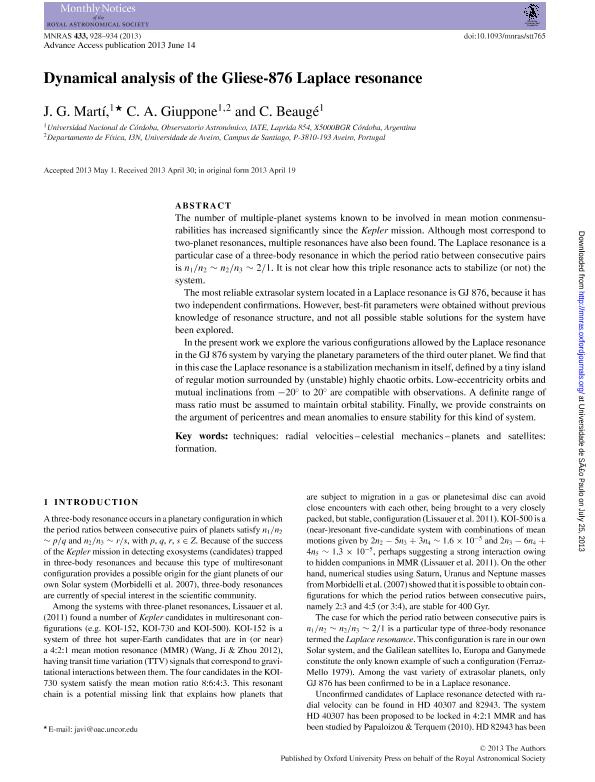Artículo
Dynamical analysis of the Gliese-876 Laplace resonance
Fecha de publicación:
06/2013
Editorial:
Oxford University Press
Revista:
Monthly Notices of the Royal Astronomical Society
ISSN:
0035-8711
Idioma:
Inglés
Tipo de recurso:
Artículo publicado
Clasificación temática:
Resumen
The number of multiple-planet systems known to be involved in mean motion conmensurabilities has increased significantly since the Kepler mission. Although most correspond to two-planet resonances, multiple resonances have also been found. The Laplace resonance is a particular case of a three-body resonance in which the period ratio between consecutive pairs is n1/n2 ∼ n2/n3 ∼ 2/1. It is not clear how this triple resonance acts to stabilize (or not) the system. The most reliable extrasolar system located in a Laplace resonance is GJ 876, because it has two independent confirmations. However, best-fit parameters were obtained without previous knowledge of resonance structure, and not all possible stable solutions for the system have been explored. In the present work we explore the various configurations allowed by the Laplace resonance in the GJ 876 system by varying the planetary parameters of the third outer planet. We find that in this case the Laplace resonance is a stabilization mechanism in itself, defined by a tiny island of regular motion surrounded by (unstable) highly chaotic orbits. Low-eccentricity orbits and mutual inclinations from −20° to 20° are compatible with observations. A definite range of mass ratio must be assumed to maintain orbital stability. Finally, we provide constraints on the argument of pericentres and mean anomalies to ensure stability for this kind of system.
Archivos asociados
Licencia
Identificadores
Colecciones
Articulos(IATE)
Articulos de INST.DE ASTRONOMIA TEORICA Y EXPERIMENTAL
Articulos de INST.DE ASTRONOMIA TEORICA Y EXPERIMENTAL
Citación
Marti, Javier Guillermo; Giuppone, Cristian Andrés; Beauge, Cristian; Dynamical analysis of the Gliese-876 Laplace resonance; Oxford University Press; Monthly Notices of the Royal Astronomical Society; 433; 2; 6-2013; 928-934
Compartir
Altmétricas




